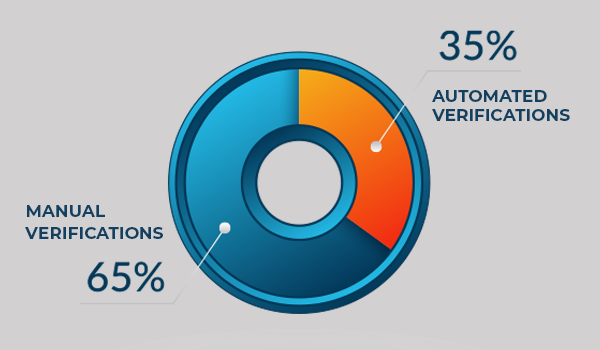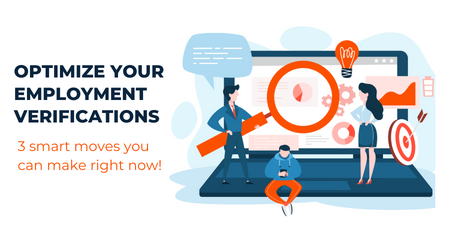Note: In December 2021 SJV and Wholesale Screening merged to become InformData.
One factor consumer reporting agencies (CRAs) consistently overlook when calculating their costs for performing employment verifications is the difference between automated verifications and those that require manual research. Often, CRAs throw these two very different processes into the same budget bucket, which means you aren’t truly capturing their real costs of performing employment verifications. But doing so may mean missing out on the opportunity to maximize your verification team’s cost-effectiveness and efficiency.
The ‘35-65’ Rule
At InformData, we have worked with countless background screening companies over the years. Our experience has put us in a unique position to understand how CRAs typically allocate their staff and resources.
One thing we’ve observed is that when you break down the average CRA’s employment verification workload, you’ll find that about 35% of the orders can be completed using automated tools. The other 65% require manual verification. (This is an approximation. The ratio varies by industry.) So, let’s say your blended cost of performing a verification is $4. That really isn’t the whole story. It means that 35% of your verifications cost you nickels and dimes which the 65% are actually costing you much more than $4.
On the positive side, these numbers are a significant improvement over the way things used to be. Automated employment verification services such as The Work Number have made checking the resumes of some job applicants nearly instantaneous.
Unfortunately, for the 65% of employment verifications that can’t be checked online, researchers must resort to the old-fashioned method: making phone calls, leaving messages, waiting for callbacks, and so on. The entire process can very often take three or four days.
The fact that so many clients impose incredibly specific calling protocols makes the manual employment verification process even more onerous. The typical verification specialist’s cubicle is festooned with sticky notes outlining complex strings of steps, such as, “Call twice, and if you don’t reach a human, call a third time. But email the client to inform them you haven’t spoken to a real person.”
All of this leads us to estimate that, when it comes to employment verifications, the average CRA dedicates about 97% of their labor to manual verification. The other 3% goes towards verifying resumes automatically.
Remember what we said about the 65-35 split in verification volume. It doesn’t take a mathematician to recognize 65:35 and 97:3 are nowhere near in alignment.
Why it matters
We’re pointing out the vast labor imbalance between automated and manual employment verifications to illustrate the efficiency boost most CRAs would see if they could somehow bring these numbers closer together.
Imagine if your team was able to run most of your employment verification orders automatically. Relieved from the tedious and time-consuming work of making and waiting for phone calls, your researchers could focus on other, more profitable tasks.
Consumer reporting agencies often see verification of employment as a low-margin service that is nevertheless a necessary element of background check packages that include higher-margin offerings such as criminal record searches. In other words, employment verification is a loss leader.
Resolving the 65-35 split would bring employment verification over into the profit column.
A strategy for more efficient employment verification
We have a solution: keep automated employment verification in-house and partner with a reliable third-party provider to perform all your manual research. Your internal team can breeze through their work with the help of automated tools while off-loading the more demanding manual jobs to your outsourced provider’s trained experts.
Why outsource? Because the best third-party employment verification vendors are set up to handle huge amounts of manual research in ways that just aren’t possible with relatively small CRA teams.
Outsourced providers:
- Allow you to scale up and down quickly, according to the demands of the market.
- Relieve you of the burden of training new hires to conduct complex manual employment verifications.
- Can typically offer faster turnaround times (TATs) and lower unable-to-verify (UTV) rates, thanks to their technology, scale, and finely-tuned processes.
- Can adapt quickly to whatever levels of customization your clients require.
Learn more about how outsourcing can help you run leaner, faster, and more effectively as a CRA in our recent article, “Why Outsource Employment and Resume Verifications?”





